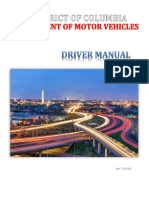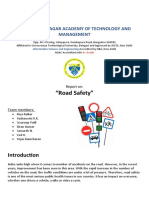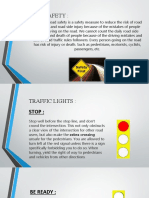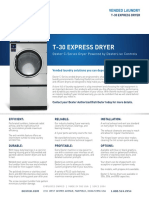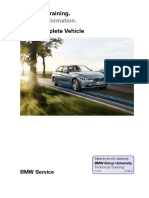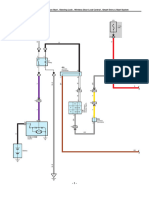67410aa672edf812e4f251d9 Rofesixisidoxigobiv
67410aa672edf812e4f251d9 Rofesixisidoxigobiv
Uploaded by
ahmedkibenderaCopyright:
Available Formats
67410aa672edf812e4f251d9 Rofesixisidoxigobiv
67410aa672edf812e4f251d9 Rofesixisidoxigobiv
Uploaded by
ahmedkibenderaOriginal Title
Copyright
Available Formats
Share this document
Did you find this document useful?
Is this content inappropriate?
Copyright:
Available Formats
67410aa672edf812e4f251d9 Rofesixisidoxigobiv
67410aa672edf812e4f251d9 Rofesixisidoxigobiv
Uploaded by
ahmedkibenderaCopyright:
Available Formats
Sheria ya usalama barabarani tanzania pdf
Sheria za barabarani. Sheria ya usalama barabarani sura ya 168 pdf. Sheria ya usalama barabarani pdf. Sheria ya usalama barabarani zanzibar. Sheria ya usalama barabarani tanzania pdf free download.
**Traffic Signals and Road Safety** The purpose of traffic signals is to ensure the safe movement of vehicles on roads. According to the Traffic Act, Chapter 168 of the Laws of Kenya, all road users must obey traffic signals and signs. The colors of traffic signals have specific meanings: * Red: Stop * Yellow: Caution or warning * Green: Go Drivers are
expected to stop at red lights and caution zones, and proceed only when the light turns green. Failure to comply with these rules is an offense under the Traffic Act. Other road users, such as pedestrians and cyclists, must also follow traffic signals and signs. Pedestrians should not cross roads except at designated pedestrian crossings or when the
traffic signal indicates it is safe to do so. Cyclists are required to ride on designated bike paths or lanes, and to obey all traffic signals and signs. **Importance of Traffic Signals** Traffic signals play a crucial role in preventing accidents and ensuring road safety. They help to manage the flow of traffic, reduce congestion, and prevent conflicts between
different modes of transport. In particular, traffic signals help to: * Prevent accidents by controlling the movement of vehicles at intersections * Reduce congestion by managing the flow of traffic * Ensure pedestrian safety by providing designated crossing areas * Encourage sustainable transportation options, such as cycling or walking
**Consequences of Ignoring Traffic Signals** Ignoring traffic signals can have serious consequences, including: * Accidents and injuries to road users * Financial losses for drivers who fail to comply with traffic rules * Damage to vehicles and infrastructure * Negative impact on the environment due to increased congestion and pollution It is essential
that all road users understand the importance of traffic signals and obey them at all times. In Tanzania, road rules must be followed. If streetlights are out due to technical or power issues, drivers should use alternative routes and avoid congested areas. When approaching intersections, drivers should give priority to those already on the road and
waiting to turn. The Highway Code of Tanzania (2008) provides guidelines for safe driving practices. Unfortunately, many drivers in Dar es Salaam fail to follow these rules, often resulting in reckless behavior such as ignoring red lights or honking at other drivers who are following the rules. I would appreciate it if someone could provide me with a
digital copy of the Highway Code, preferably with pictures and illustrations to make it easier to understand. The code can be found online, but having a physical copy would be helpful. Relevant sections of the Highway Code include: * Rules for driving at night * Safe driving practices near intersections and pedestrian crossings * Guidelines for sharing
the road with other users (e.g. pedestrians, cyclists) * Consequences for reckless or negligent driving If you could provide me with a digital copy of the Highway Code, I would be grateful. (Note: I have removed unnecessary text and focused on providing a clear summary of the original message) 1 Dibaji Kanuni za Barabara ni jumla ya kanuni na
ushauri wa namna ya kutumia barabara zetu. Kanuni hizi zinahusisha kanuni ya barabarani na desturi ya uendeshaji mzuri. To all road users who can be expected to drive safely - you also have a responsibility to follow the rules. We urge all road users to learn the Highway Code and follow the advice given. If everyone follows these rules, road safety
will improve and become more enjoyable. The Highway Code is an official guide to using our roads safely and in good condition. It's designed for anyone who uses our roads, including pedestrians, cyclists, motorists, and horse riders. The rules are straightforward and easy to understand, making it simple for everyone to follow. To avoid accidents,
always use your common sense and be mindful of others on the road. Never assume someone else will see or react in time, and never take unnecessary risks. The Highway Code is a guide, not a set of hard-and-fast rules - but failing to follow its advice can lead to serious consequences, including fines, penalties, and even imprisonment. As our roads
get busier, it's essential that we all work together to keep them safe. Always be aware of your surroundings and the people around you, and never assume someone else will take responsibility for their own safety. The Highway Code is constantly being updated to reflect new technologies and changes in road usage. Here are some key definitions from
the Highway Code: * "Dereva" refers to anyone who drives a vehicle or uses other equipment (including bicycles) on the road. * "Njia mbili" means two lanes of traffic that are separated by barriers or signs, indicating one-way traffic flow. * "Kuruhusu wengine" means allowing others to pass you, which can help prevent congestion and accidents. *
"Njia" refers to a section of the road used for driving in one direction. * "Mtumiaji wa barabara" means anyone using the road, including pedestrians, cyclists, motorists, and horse riders. * "Magari barabarani" refers to vehicles on the road. * "Gari" is any vehicle traveling on the road, regardless of its type or size. * "Alama za pundamilia" are safety
signs indicating pedestrian crossings. The Highway Code is produced by the Road Safety Agency in collaboration with the Police Service and other organizations. Its purpose is to provide clear guidance for all road users, helping us to stay safe on our roads. Ya Maendeleo la Denmark. Vyanzo vingi vilipitiwa ili kupata ushauri mzuri wa kutumia
barabara kiusalama. Waandishi wanapenda kushukuru kwa kutumia maarifa ya Mwongozo wa SATCC kwa Madereva Wanafunzi, Sheria za Barabara za Uganda, na rasimu ya mwanzo ya Sheria za Barabara iliyotungwa na Chuo cha Taifa cha Usafi rishaji. Jumuia ya Msalaba Mwekundi Tanzaniakwa ukarimu walitusaidiakatika sehemu ya “Msaada wa
Kwanza”. Kwa nguvu mikono yao. Kutembea kwenye kundi. Iwapo kundi la watu linashiriki kwenye matembezi yaliyopangwa barabarani, watembea upande wa kulia. Waandaaji wahakikishe kuna walinzi mbele na nyuma waliovaa nguo zinazong'aa katika mwanga wa mchana na nguo zinazoakisi wakati wa giza. Highway Code-Inside-Swa.indd Sec1:6
Kuvuka barabara: 1. Tafuta sehemu salama ya kuvuka 2. Simama kwenye ukingo wa barabara 3. Angalia magari barabarani kushoto, kulia na sehemu zote kukuzunguka, na sikiliza 4. Kama kuna gari linakuja liache lipite 5. Wakati hakuna gari linalokuja, vuka moja kwa moja barabara-usikimbie 6. Angalia na sikiliza magari wakati wa kuvuka Mahali
salama pa kuvukia: * Kwenye taa za barabarani * Kwenye alama za pundamilia * Madaraja ya waendea kwa miguu na njia za chini * Au mahali ambapo ni ofi sa wa polisi, mwongoza kivuko cha shule au magari Kuvuka kwenye kizingwa. Iwapo kuna kizingwa katikati ya barabara, tumia Kanuni za Uvukaji kuvuka hadi kwenye kizingwa na kisha simama.
Tumia utaratibu uleule kuvuka sehemu iliyobaki ya barabara. Kuvuka kwenye alama za pundamilia. Iwapo kuna alama za pundamilia karibu zitumie. Mpe dereva muda wa kutosha kukuona na kusimama kabla ya kuvuka. Kisha vuka moja kwa moja, lakini endelea kuangalia na kusikiliza. When driving, use your mirror to check your surroundings and
ensure you can see all sections of the road. Come to a complete stop before entering an intersection or changing lanes. At night, slow down and use high-beam headlights to illuminate the road ahead. If there are no streetlights, use flares or reflectors to make yourself visible. Avoid driving close behind another vehicle, especially at night. Use caution
when approaching intersections, roundabouts, or pedestrian crossings. When driving with children, ensure they are securely fastened in their car seats and always wear a helmet while cycling. When driving at night, use headlights and taillights that can be seen from a distance. Follow traffic rules and signs, including those specific to pedestrians,
cyclists, and emergency vehicles. Be aware of potential hazards on the road, such as potholes or debris. Always check your mirrors and blind spots before changing lanes or turning. When driving at night, use high-beam headlights and taillights that can be seen from a distance. Wear reflective clothing or accessories to increase visibility. Check your
vehicle's maintenance regularly to ensure it is in good working condition. Use your horn to alert other drivers of your presence, especially at night. Remember to follow traffic laws and regulations, including those specific to pedestrians, cyclists, and emergency vehicles. Be aware of potential hazards on the road and take necessary precautions to
avoid accidents. When driving, always be aware of your surroundings and follow traffic rules. When stopping or turning, use a good hand signal to show your intention. Be careful when driving in rural areas, where roads may be narrow and winding. Before starting your journey, make sure you are not tired or affected by medication. Use your mirrors
properly and check your blind spots regularly. Always look ahead and anticipate potential hazards like potholes, pedestrian crossings, and roadworks. When approaching a junction, slow down and be more cautious as other drivers may not see you. If the road is shared with pedestrians or cyclists, give them priority and avoid sudden movements. Do
not drive under the influence of alcohol or drugs and use your horn only when necessary. When driving on highways, follow the marked lanes and keep to the left unless passing another vehicle. Be aware of vehicles that may be entering or exiting the highway and slow down if you need to pass a slower-moving vehicle. Ikiwa unakuja kupitia barabara
ya njia kuu kwenye njia iliyo upande wa kushoto na kuendelea kupita kushoto, chukua tahadhari kubwa kwani unaweza hitaji kukata chukua madereva kuonyesha kuwa wako nje ya mzunguko. Angalia magari yaliyokatisha nyuma au kuondoka kwenye njia na tokea. Ikiwa una uhakika, ni salama kuyaacha magari marefu kupita kwenye barabara kabla
ya kuendelea. Iwapo hauwezi kuhesabu usalama wako, simama na shuka kwenye baiskeli yako na tokea nayo kwenye njia ya watembea kwa miguu. Tumia Kanuni za Uvukaji wakati unapita kwenye barabara ya kuingilia. Ishara zinazoongoza makutano na fuata maelekezo yanayotolewa na ishara ya taa za njia kuu. Ikiwa ni pamoja, usimame ikiwa
ishara nyekundu au za njano itaonyeshwa. Simama kwenye sehemu iliyoandikwa SIMAMA au fuata nafasi yako kwenye mstari wa magari yanayosubiri. Ikiwa utakuwa kwenye barabara, usiendeshe baiskeli kupita kwenye alama za pundamilia au ishara inayowaongoza watembea kwa miguu. Shuka na vuka ukitembea na baiskeli yako. Ikiwa utakuwa
kwenye barabara, chukua tahadhari kubwa kwani vyombo vya usafi riko mara nyingi vitakuwa vinakwenda kasi sana. Subiri kupata upenyo ulio salama na vuka kila barabara. Sheria za abiria anayetumia mabasi, daladala, teksi na pikipiki Daima, subiri mabasi, daladala na teksi kwa kuenda kwenye vituo maalum. Subiri gari pembeni na si barabarani.
Subiri kabisa kabla ya kupanda au kushuka. Daima subiri wengine washuke kabla hujapanda. Uwe makini wakati unafungua mlango wa gari – unaweza kumgonga mtu. Shuka kwenye gari tu kwenye vituo vinavyotambulika. Kamwe usifanye mambo yafuatayo: kupanda kwenye gari linaloonekana kuwa bovu na limechakaa, kupanda pikipiki ambayo
tayari imejaa. Kuing’inia nje ya gari. Kushawishi madereva kuendesha kwa usalama. As a driver, you must respect traffic rules. If you don't follow them, pull over to a safe spot and report your vehicle's registration number to the police. It's better to pay the fine than risk losing your life. As a driver or co-driver, you should not try to cram more
passengers into the vehicle when it is already full. You must ensure that any animals you are transporting are properly secured, whether they are alone or in a group. In hazardous areas, such as sharp corners and steep inclines, one person should lead while the other follows behind. At night, use your headlights to warn other drivers of oncoming
traffic - one person should be 100 meters ahead of the animals and the other 100 meters behind. You must not drive at night without a police permit for transporting more than 50 animals on any road or street. The Highway Code emphasizes: * You must have a valid driving license for the type of vehicle you are driving. * You must not be drunk or
tired while driving. * You must be able to see clearly (within 20 meters) and not use sunglasses at night. * You should not drive under the influence of alcohol or drugs. * Children under 10 years old must sit in a child seat or booster seat, and all passengers must wear seatbelts. Additionally: * Your vehicle must be in good condition and have valid
registration and insurance. * Your vehicle must meet safety standards and have a maximum weight capacity. * You should not overload your vehicle with cargo that exceeds the manufacturer's recommended weight limit. * Your vehicle must have functioning brakes, lights, and mirrors. Remember to regularly inspect and maintain your vehicle's tires,
fluids, and other essential systems. Kuendesha gari kazi vizuri inahitajika kuwa na hewa ya kutosha, kuvaa vikinga macho, mabuti magumu, glovu, na nguo ambazo zitakukinga iwapo utaanguka. Dereva wa pikipiki au skuta lazima avae helmeti ya usalama iliyothibitishwa ambayo imefungwa kiusalama. Abiria wa kiti cha nyuma lazima wakae kwa
kutanua miguu kwenye kiti halisi na kuweka miguu yote miwili kwenye sehemu ya kukanyagia. Kuendesha gari usiendeshe wakati unaumwa, hali nzuri inahitajika. Usinywe pombe kabla ya kuendesha. Kumbuka kuwa inachukua muda kwa kileo kuondoka mwilini mwako, hivyo unaweza kutokuwa katika hali nzuri ya kuendesha jioni baada ya kunywa
pombe wakati wa chakula cha mchana. Kuendesha gari la siri lazima uwe na leseni halali ya dereva mwanafunzi, na wakati unaendesha lazima uwe unaongozwa na mwalimu wa udereva aliyesajiliwa anayefanya kazi kwenye shule ya udereva iliyothibitishwa. Always drive cautiously. Avoid reckless driving and never compromise on safety. Always be
aware of your surroundings, including potential hazards – don't focus solely on one spot for too long. Drive slowly and carefully, especially in areas where there may be pedestrians or children playing. If you see a pedestrian crossing the road, slow down and let them pass. Don't speed up to overtake another vehicle; instead, let it pass and maintain a
safe distance. Don't use your phone while driving – not even for a quick glance. Instead, pull over at a safe spot and answer your call or check your messages. Always keep an eye out for potential hazards ahead, such as pedestrians, children, or animals crossing the road. If you see someone about to cross the road, slow down and let them pass. Be
aware of your surroundings at all times. Don't assume that there are no vehicles nearby just because you don't see any – always keep an eye out for potential hazards. If you notice a vehicle approaching from behind or overtaking another vehicle ahead, be prepared to take evasive action if necessary. Don't use hazard lights unnecessarily. Only use
them when there's a genuine emergency, such as a breakdown or accident. Always turn off your hazard lights once the situation has been resolved. Remember that road safety is everyone's responsibility – always drive defensively and anticipate potential hazards ahead. Before leaving, always check your rearview mirror and blind spots to ensure the
road is clear. If you're satisfied that it's safe to proceed, indicate your intention to do so. Always signal left when turning or changing direction. Use your mirrors regularly to know what's happening behind and around you. Signal before changing direction or lane, and then wait for a suitable gap. Drive slowly on roads without lanes, especially at night,
as it may be difficult to see pedestrians, cyclists, animals, or vehicles stopped or slowing down. On roads with no lines, drive even more slowly, ease off the accelerator, and avoid sudden braking. Remember to always stop in time to avoid hitting anything. Adjust your speed according to the road conditions and weather. Large vehicles like trucks and
motorcycles take longer to stop than smaller ones, so leave a bigger gap. Always keep a safe distance from the vehicle ahead. Remember, "one hundred and one" when driving! Before you start your journey, make sure you have a safe distance from the vehicle in front of you. Follow the speed limit: for all vehicles, it's 50 km/h in residential areas (no
warning signs), while on highways, it's 80 km/h for large vehicles (>3.5 tons) and public service vehicles (buses, trucks, etc.) outside residential areas. For smaller vehicles, it's 100 km/h on highways. When approaching a junction or pedestrian crossing, slow down and be prepared to stop. Avoid sudden stops or sharp turns that could cause an
accident. Before overtaking another vehicle, ensure: * the road ahead is clear * the vehicle you're about to overtake isn't already turning into your lane * there's sufficient space between your vehicles Only overtake if it's safe and you have enough room to do so without causing a hazard to other drivers or pedestrians. If you're unsure, don't overtake.
When approaching a roundabout or intersection with no clear path, slow down and be prepared to stop. Remember to always follow the speed limit and adjust your speed according to road conditions and traffic. When driving on the highway, always ensure your vehicle is in a safe position before overtaking another car. Before starting to overtake,
make sure there are no obstacles ahead and check your rearview mirror. Use your indicators and slow down if necessary. If you're unsure about the road conditions or the speed of the approaching traffic, do not overtake. Always give way to bicycles and motorbikes that are slower than your vehicle. When overtaking, go as quickly as possible but still
in a safe manner. If you encounter a car that is slowing down or turning ahead, do not overtake. Be cautious when approaching intersections and roundabouts. Always follow traffic signs and signals. When approaching an intersection with no traffic lights or signs, slow down and be prepared to stop. If there are pedestrians or vehicles on the other
side of the road, give way to them. Always keep a safe distance from other vehicles and be prepared to stop in time. **Important Rules for Driving in Swahili** When driving, always be aware of your surroundings and follow these rules: * When there are no signs or markings, always yield to oncoming traffic. * Always slow down and come to a stop if
you're approaching an intersection where other cars are turning. * Never enter an intersection unless it's clear that the way is safe for you to proceed. * Wait and let other cars pass before proceeding. **Rules for Turning Left** 1. Make sure it's safe to turn left by checking your rearview mirror and looking out for oncoming traffic. 2. Signal your
intention to turn left and start turning slowly. 3. Turn into the left lane of the road, but only if there are no other cars approaching from behind. 4. Be cautious of pedestrians, cyclists, and motorcyclists who may be approaching from the side you're turning onto. **Rules for Turning Right** 1. Check your rearview mirror to make sure it's safe to turn
right, and look out for oncoming traffic. 2. Signal your intention to turn right and start turning slowly. 3. If the road ahead is clear, proceed with caution, but don't cut off other cars. 4. Be aware of pedestrians, cyclists, and motorcyclists who may be approaching from the side you're turning onto. **Rules for Turning at Intersections** 1. When
approaching an intersection where two roads meet, check to see if there's enough space for your vehicle to pass through without stopping or slowing down. 2. If not, slow down and wait until it's safe to proceed. 3. Always yield to oncoming traffic when turning onto a road. **Additional Rules** * Always be aware of other cars, pedestrians, cyclists, and
motorcyclists around you. * Never cut off another car or impede its progress. * Follow the normal rules for driving in your area. Note: The original text is from the Swahili version of the Highway Code. When driving, always use your indicators correctly, except when turning green. If you're following yellow traffic lights, slow down and be prepared to
stop if necessary. When approaching intersections or roundabouts, reduce your speed and make sure it's safe to proceed. Some specific guidelines for drivers include: * When turning left: indicate left, turn onto the left lane, allow other cars in the intersection to pass, and then continue straight. * When driving straight: indicate straight, merge with
traffic, and follow the flow of traffic. * When approaching a roundabout: slow down, check your mirrors and blind spots, and signal your intention to exit the roundabout. Additionally, it's important to: * Always use your headlights when driving at night or in poor weather conditions. * Reduce your speed when driving in foggy or snowy conditions. * Be
aware of pedestrians and cyclists on the road. * Avoid sudden stops or changes in direction that could cause confusion or accidents. * Use your indicators correctly to avoid confusing other drivers. Remember, always drive defensively and be prepared for unexpected situations. When driving at night or in heavy rain, make sure you can see well over
100 meters. Don't use high-beam headlights as they can cause glare for other drivers and make it difficult to see. Adjust your headlights so that they are not too bright or dim. Turn them off when approaching other vehicles or pedestrians. When reversing, make sure the area is clear of people and vehicles. Check your mirrors and blind spots before
reversing. Use your rearview mirror to check for any obstacles. If you can't see well, look out for someone to guide you. When parking, avoid areas with overhead hazards like power lines or tree branches. When stopping or turning, use your indicators to signal your intentions. Get out of the vehicle and check the area before opening the door. Look
out for pedestrians, cyclists, and motorcyclists who may be approaching from behind. Use your rearview mirror to check for any obstacles when reversing. Remember to always yield to other vehicles and pedestrians when stopping or turning. Use your indicators to signal your intentions even if you're not actually turning. When reversing in a busy
area, use your mirrors and blind spots to ensure the area is clear. When approaching a junction, follow these guidelines: • Drive on the left-hand side of the road. • Be aware of pedestrian crossings and traffic signals. • If you're approaching a taxi rank or a bus stop, slow down and be cautious. • Always check your mirrors and brakes before slowing
down. • Use your indicators to signal your intentions. At night or in areas with heavy traffic, use your headlights and indicate carefully. Be extra cautious when pedestrians are walking on the road. If you can't avoid pedestrians, reduce your speed and keep a safe distance. When approaching pedestrian crossings, be prepared to slow down and give
way. Use your indicators and brake lights to signal your intentions. Give way to pedestrians who are crossing the road. Be aware of elderly people and those with disabilities who may be more vulnerable when walking on the road. Be extra cautious when approaching intersections or roundabouts. When sharing the road with cyclists, motorcyclists, or
other vehicles, use your mirrors and brake lights to signal your intentions. Keep a safe distance from these vehicles and be prepared to slow down or stop if necessary. Always follow traffic signals and pedestrian crossings. If you're unsure about what to do, look out for signs indicating the direction of traffic flow. When driving, especially on highways
or in emergency situations, follow traffic rules and signs. If you see an approaching police vehicle or ambulance, slow down and pull over to let it pass. Be aware of your surroundings and follow the instructions of authorities. At railroad crossings, stop before entering the tracks if you hear a warning signal or see a flagman. Do not speed up when
trying to beat a train at a crossing. When stopped at an intersection or pedestrian crossing, make sure pedestrians have cleared the area before proceeding. If your vehicle is stuck in traffic, do not attempt to pass another car on the left or right side of the road. Instead, follow the flow of traffic and wait for a gap to open up. If you are involved in an
accident or experience mechanical issues with your vehicle, move it to the side of the road as quickly and safely as possible. If you need assistance, call the police or a tow truck. Remember to always prioritize safety when driving on highways or in areas prone to accidents. Before an accident occurs, make sure your car's lights are functioning
properly and that there are no hazards on the road. If you are involved in an accident or see one happening, follow these steps: * Alert other drivers by flashing your hazard lights * Move to a safe location if possible * Call the police immediately and provide them with information about the incident, including the location and number of vehicles and
people involved * Stay calm and do not move until the authorities arrive If someone is injured in an accident, follow these steps: * Provide first aid if necessary * Put out fires or extinguish sparks on clothing * Remove anyone who is trapped from the vehicle * If possible, stabilize any injured persons to prevent further harm * Call for medical help and
provide information about the incident Remember that it's crucial to report accidents to the police as soon as possible. This helps them to identify the cause of the accident and take action against those responsible. Finally, if you are involved in an accident and no one is injured, you should still report the incident to the police. **Emergency
Procedures** Before assisting, make sure your own safety comes first. Identify potential dangers and take necessary precautions to avoid accidents. If there's a risk of fire, ensure no one is smoking or using open flames. 1. **Primary Survey** Prioritize saving lives. Check for any life-threatening injuries and treat them first. Ensure the environment is
safe before providing aid. Be aware of your surroundings and watch out for potential hazards. 2. **Life-Threatening Injuries** The most critical thing to do in an emergency is to save lives. Remember "D-C-A" which stands for: Danger - Is there ongoing harm to the injured person? Response - Is there any response from the injured person? Airway - Is
the airway (breathing) clear? Perform a primary survey by checking the airway, breathing, and circulation. **Cardiopulmonary Resuscitation (CPR)** If someone is not breathing or has no pulse, start CPR. If you are unsure what to do, follow these steps: - Check for any blockage in the airway - Start rescue breaths - Check for a pulse and continue
CPR if there isn't one **Seek Medical Help** Once you have started CPR, call for medical help as soon as possible (911). Do not leave the person alone until medical professionals arrive. If you are trained in CPR, continue providing aid until the situation is under control. **Additional Tips** - Keep an eye on the injured person's airway, breathing, and
circulation - Continue to provide CPR if there is no pulse or breathing - If someone is conscious but unable to respond, move them to a safe location and monitor their vital signs Remember, your safety is crucial in emergency situations. Always prioritize your own well-being before assisting others.
You might also like
- The Official New Zealand Road CodeDocument136 pagesThe Official New Zealand Road Codegeninho383% (6)
- The Official DVSA Guide to Riding - the essential skills: DVSA Safe Driving for Life SeriesFrom EverandThe Official DVSA Guide to Riding - the essential skills: DVSA Safe Driving for Life SeriesRating: 5 out of 5 stars5/5 (1)
- Dokumen - Tips The Traffic Code Handbook Bermuda Signalcontrolledcrossings Where TheDocument57 pagesDokumen - Tips The Traffic Code Handbook Bermuda Signalcontrolledcrossings Where TheNurdana BoranbayevaNo ratings yet
- Highway Code MalaysiaDocument10 pagesHighway Code MalaysiaSyafeena Insyirah100% (1)
- Kenya Learner Driver HandbookDocument84 pagesKenya Learner Driver HandbookaganoelmoegaNo ratings yet
- Nigeria Highway Code and Standards Parts 1-2-3 Explained 2022Document72 pagesNigeria Highway Code and Standards Parts 1-2-3 Explained 2022spencer onyiriNo ratings yet
- Tanzania Highway CodeDocument64 pagesTanzania Highway CodeIgnas Kawedi71% (7)
- Road Safety PresentationDocument22 pagesRoad Safety PresentationMahesh Ramteke71% (7)
- Obeying and Observing Traffic Rules and RegulationsDocument18 pagesObeying and Observing Traffic Rules and Regulationsflorence baliwang64% (11)
- DSA Highway Code Browse InsideDocument8 pagesDSA Highway Code Browse InsideArif Mehmood43% (7)
- Ntsa Private Light Vehicles Learner's Handbook 2017Document84 pagesNtsa Private Light Vehicles Learner's Handbook 2017EXPRESS DIGITAL HUB100% (1)
- Vid (1)Document64 pagesVid (1)Tinaye Vanessa ChibvongodzeNo ratings yet
- The Official Highway Code: DVSA Safe Driving for Life SeriesFrom EverandThe Official Highway Code: DVSA Safe Driving for Life SeriesRating: 3.5 out of 5 stars3.5/5 (26)
- Highway CodeDocument64 pagesHighway CodeLara100% (3)
- RTD Highway Code PDFDocument92 pagesRTD Highway Code PDFJeffrey Michael ChiwaulaNo ratings yet
- NSS 1Document22 pagesNSS 1Moshika VetrivelNo ratings yet
- Road SafetyDocument7 pagesRoad Safetykavitarsharma2979No ratings yet
- Mygov 1000000000513446991Document2 pagesMygov 1000000000513446991vijayprakashs287No ratings yet
- To Stay SafeDocument6 pagesTo Stay SafeAASEEN ALAMNo ratings yet
- Roadsafetypresentationbyfaisalayub 160507085655 2Document15 pagesRoadsafetypresentationbyfaisalayub 160507085655 2shabaj_p200No ratings yet
- Traffic RegulationsDocument5 pagesTraffic Regulationskelechianukanti083No ratings yet
- Road Signs: Hom e - Post Your Com M Ents - Sitem ApDocument4 pagesRoad Signs: Hom e - Post Your Com M Ents - Sitem ApsharmilaNo ratings yet
- Road SafetyDocument4 pagesRoad SafetyANMOL SAHOO100% (1)
- California Driver's Handbook: 2 Manuscripts in 1 - Your Complete Resource for Safe and Responsible DrivingFrom EverandCalifornia Driver's Handbook: 2 Manuscripts in 1 - Your Complete Resource for Safe and Responsible DrivingNo ratings yet
- Presentation Name: Pedestrians Safety in Road Traffic: Group MembersDocument14 pagesPresentation Name: Pedestrians Safety in Road Traffic: Group MembersMaxamed YusufNo ratings yet
- Rules of The RoadDocument232 pagesRules of The RoadKiam Lavanagh100% (1)
- Participating in Dutch TrafficDocument8 pagesParticipating in Dutch Trafficwotelo5707No ratings yet
- Highway Code EN - PDF - 20130927083609 PDFDocument90 pagesHighway Code EN - PDF - 20130927083609 PDFBG100% (1)
- shivanitDocument8 pagesshivanitshantanutiwari7777No ratings yet
- Road Safety Begins With MeDocument2 pagesRoad Safety Begins With Mebhoopesh_kumawatNo ratings yet
- Awareness On TrafficDocument14 pagesAwareness On TrafficISLAVATH SANDHYANo ratings yet
- Columbia DLDocument117 pagesColumbia DLarun.gauttam06No ratings yet
- Road SafetyDocument3 pagesRoad SafetyRohitNo ratings yet
- Important Road Safety TipsDocument2 pagesImportant Road Safety TipsReginah KalimiNo ratings yet
- RSPDocument3 pagesRSPAbhi XNo ratings yet
- Road SafetyDocument48 pagesRoad SafetyHazel BustineraNo ratings yet
- Ras Group ReportDocument30 pagesRas Group Report1DT20IS083 Samarth NNo ratings yet
- Road Safety PresentationDocument15 pagesRoad Safety PresentationNandi Sujay100% (1)
- Obeying Traffic Laws-Tips On Making The Road A Safer PlaceDocument2 pagesObeying Traffic Laws-Tips On Making The Road A Safer PlaceGElla BarRete ReQuilloNo ratings yet
- Unit2 Part 1Document72 pagesUnit2 Part 1Sumit Kumar SinhaNo ratings yet
- Road Safety ChaptersDocument30 pagesRoad Safety Chapterssukesh28No ratings yet
- Lab 1Document4 pagesLab 1sayed mohamedNo ratings yet
- Cycle Safety BookletDocument12 pagesCycle Safety Bookletapi-308565458No ratings yet
- Road Safety Awareness ProgrammeDocument13 pagesRoad Safety Awareness ProgrammeHerradlin100% (1)
- Road Safety Pocket GuideDocument33 pagesRoad Safety Pocket GuideDMCNo ratings yet
- ACKNOWLEDGEMENT EvsDocument9 pagesACKNOWLEDGEMENT EvsShivam ChoudhuryNo ratings yet
- Essay PYPyara SDocument2 pagesEssay PYPyara S7scv6ny8cn100% (1)
- TDC-15-S-07-3 Active Transport and Light Mobility VehicleDocument16 pagesTDC-15-S-07-3 Active Transport and Light Mobility VehicleSanty UyNo ratings yet
- Republic of The PhilippinesDocument3 pagesRepublic of The PhilippinesrhomielferrerNo ratings yet
- Extra Unit-Highway CodeDocument5 pagesExtra Unit-Highway CodeBelen MartinezNo ratings yet
- Rse U1Document19 pagesRse U1021- IMRANNo ratings yet
- Using The Roads SafelyDocument2 pagesUsing The Roads Safelyteresasue123No ratings yet
- Road SafetyDocument2 pagesRoad SafetyChong Wan Yik100% (1)
- Ảnh Màn Hình 2024-08-10 Lúc 20.30.55Document1 pageẢnh Màn Hình 2024-08-10 Lúc 20.30.55famitabkNo ratings yet
- Normal 640bf1d11f81cDocument3 pagesNormal 640bf1d11f81cxatogiv661No ratings yet
- Essay About Good Driving Vs Bad DrivingDocument2 pagesEssay About Good Driving Vs Bad DrivingDaly HernandezNo ratings yet
- Bicycling The Town of Breckenridge Public Education 7-28-10Document4 pagesBicycling The Town of Breckenridge Public Education 7-28-10summitdailyNo ratings yet
- Traffic Rules EssayDocument1 pageTraffic Rules EssayJhonNo ratings yet
- Motorway Driving (2nd edition): DVSA Safe Driving for Life SeriesFrom EverandMotorway Driving (2nd edition): DVSA Safe Driving for Life SeriesRating: 5 out of 5 stars5/5 (1)
- How to Teach Your Teenager Safe Driving: Psychological and Safety Aspects of Driving, with Advanced Driving TechniquesFrom EverandHow to Teach Your Teenager Safe Driving: Psychological and Safety Aspects of Driving, with Advanced Driving TechniquesNo ratings yet
- Dexter Specifications T-30 COMERCIALDocument2 pagesDexter Specifications T-30 COMERCIALmairimsp2003No ratings yet
- DRAGO 2 Manual ENDocument52 pagesDRAGO 2 Manual ENmarkoNo ratings yet
- Srs Airbag: SectionDocument46 pagesSrs Airbag: SectionАндрей НадточийNo ratings yet
- Fault Codes: STO U AndriivDocument4 pagesFault Codes: STO U AndriivAtochkavNo ratings yet
- Airport Planning and DesignDocument203 pagesAirport Planning and DesignSushant SauravNo ratings yet
- E-Pass: (Ministry of Railways) Per Child)Document3 pagesE-Pass: (Ministry of Railways) Per Child)NeeteshNo ratings yet
- N38496 - UN-26JUN89: 9950 Cotton PickerDocument605 pagesN38496 - UN-26JUN89: 9950 Cotton PickerEdinaldo GuimaraesNo ratings yet
- Center 1 Chain Drive System-Reflections: Construct and Explain The Operation of A Drive System That Uses A ChainDocument6 pagesCenter 1 Chain Drive System-Reflections: Construct and Explain The Operation of A Drive System That Uses A Chainkwedman7992No ratings yet
- Acdelco Tis2web 2019 Scan Tool ChartDocument2 pagesAcdelco Tis2web 2019 Scan Tool ChartboirxNo ratings yet
- Htl3010 3510 4010 Operator ManualDocument224 pagesHtl3010 3510 4010 Operator ManuallucelikingnandodeNo ratings yet
- RWT HardLite150Oct121Document2 pagesRWT HardLite150Oct121ronaldoNo ratings yet
- JSS 3 Self Assessment ChecklistDocument5 pagesJSS 3 Self Assessment Checklistpanoy subang100% (1)
- 06 1963 CH-BrakesDocument20 pages06 1963 CH-BrakesJose LaproviteraNo ratings yet
- Op A900biDocument212 pagesOp A900biReza HazratNo ratings yet
- Unit 4 Formation WorksDocument202 pagesUnit 4 Formation WorksGobinda BistaNo ratings yet
- ZF Steering Columns - ZF LenksystemeDocument2 pagesZF Steering Columns - ZF LenksystemewurtukukNo ratings yet
- KomawamexodijosubagemoxDocument3 pagesKomawamexodijosubagemoxSremathy NarayananNo ratings yet
- 03 - F30H Complete VehicleDocument106 pages03 - F30H Complete VehiclePepo MenéndezNo ratings yet
- VR VS Standard ConnectorsDocument1 pageVR VS Standard ConnectorserikspNo ratings yet
- Vios NCP93 # SesDocument17 pagesVios NCP93 # SesMyo Myint HtweNo ratings yet
- Kandungan Dan Susunatur Portfolio Kompetensi Calon LPMDocument11 pagesKandungan Dan Susunatur Portfolio Kompetensi Calon LPMMd ZamzuriNo ratings yet
- Form View: Tender/Proposal DetailDocument4 pagesForm View: Tender/Proposal DetailRefatkishor KishorNo ratings yet
- Title 27 / Subchapter 19Document12 pagesTitle 27 / Subchapter 19GreenockNo ratings yet
- Ficha Demostrativa Hcr1500-Ed IIDocument6 pagesFicha Demostrativa Hcr1500-Ed IIJuanPabloRiveraFloresNo ratings yet
- NCHRP Syn 222Document105 pagesNCHRP Syn 222Rainer TafurNo ratings yet
- Poshith Gowda Project Report Final Doc (1) FIDocument41 pagesPoshith Gowda Project Report Final Doc (1) FIPoshith GowdaNo ratings yet
- City Crossword 2Document1 pageCity Crossword 2Ana SchwerzNo ratings yet
- Slipform PaverDocument2 pagesSlipform Pavergk_kishoree81No ratings yet
- Over Head CraneDocument83 pagesOver Head CraneKalaiarasi Bst KWNo ratings yet
































